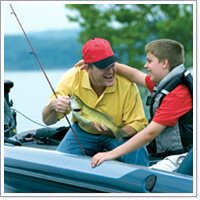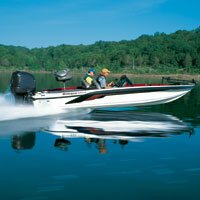Fishing Line
Line is rated in pounds test, which is the maximum weight in pounds the line can lift without breaking.
Braided Line
Multiple fibers of polyester, Kevlar or other synthetic materials are braided to form a strong, thin line that is flexible and casts well. Braided lines must be handled carefully since they can cut like a knife when under tension.
Monofilament Line
Most often chosen among anglers. This line is of an extruded polymer and is inexpensive, clear in the water easy to knot. It casts well. More expensive polymers give added properties of flexibility, limp castability and resist taking a “set” or holding the coil shape as it comes off the reel. Copolymers are extruded with a strong outer polymer and a limp inner polymer for added flexibility and durability.
Line Color
Lines are molded or braided in various colors to be least visible in water. Lighter colors or clearer lines are best in clearer water. Fluorocarbon is a polymer offering extremely strong tensile strength and near invisibility in the water. Flou8rocarbon is more costly and is often used in short lengths as a leader on a less expensive line.
Fishing Sinkers
Weights made from lead, steel or titanium are molded into various sizes and shapes. Sizes for freshwater applications range from BB for panfish to 6 ounces for catfish. Popular sinker shapes include split shot, rubber core, drop shot, bank, bullet, egg, casting, flat, pyramid and walking.
Bobbers and floats
Used mainly as strike indicators, floats also hold baits at a desired level. Most bobbers are made of cork, balsa, foam or plastic. Fixed floats have a clip-on device for fastening to the line. Slip floats allow line to slide through the float up to a bobber stop.
Leaders
A stiff wire is used to provide extra strength and toughness to withstand the cutting of sharp teeth and gills of walleye, musky and northern pike. A smaller diameter line is frequently used for fly fishing to create a nearly invisible connection between the main line and the lure.
Snaps
Tied to the main line, a snap provides a quick and easy way to change hooks or lures. A snap operates like a safety pin. Snap swivels combine a snap with a swivel and are commonly used to keep line from twisting while retrieving lures.
Swivels
Frequently used as a connection between the main line and a leader, swivels permit a lure to rotate without twisting the line and do not inhibit lure action. Swivels are also used to provide a “stop” between a sliding sinker and the lure or bait. Swivel sizes decrease with higher numbers so a number 1 swivel is larger than a number 12 model.
Bait spreader
A line tie or jighead with flexible wires spread out on the rear of the rig. Soft plastic lures or plugs can be added to each wire so when the rig is trolled or retrieved it looks like a school of fleeing baitfish. Umbrella lures are a variation of this rig.

